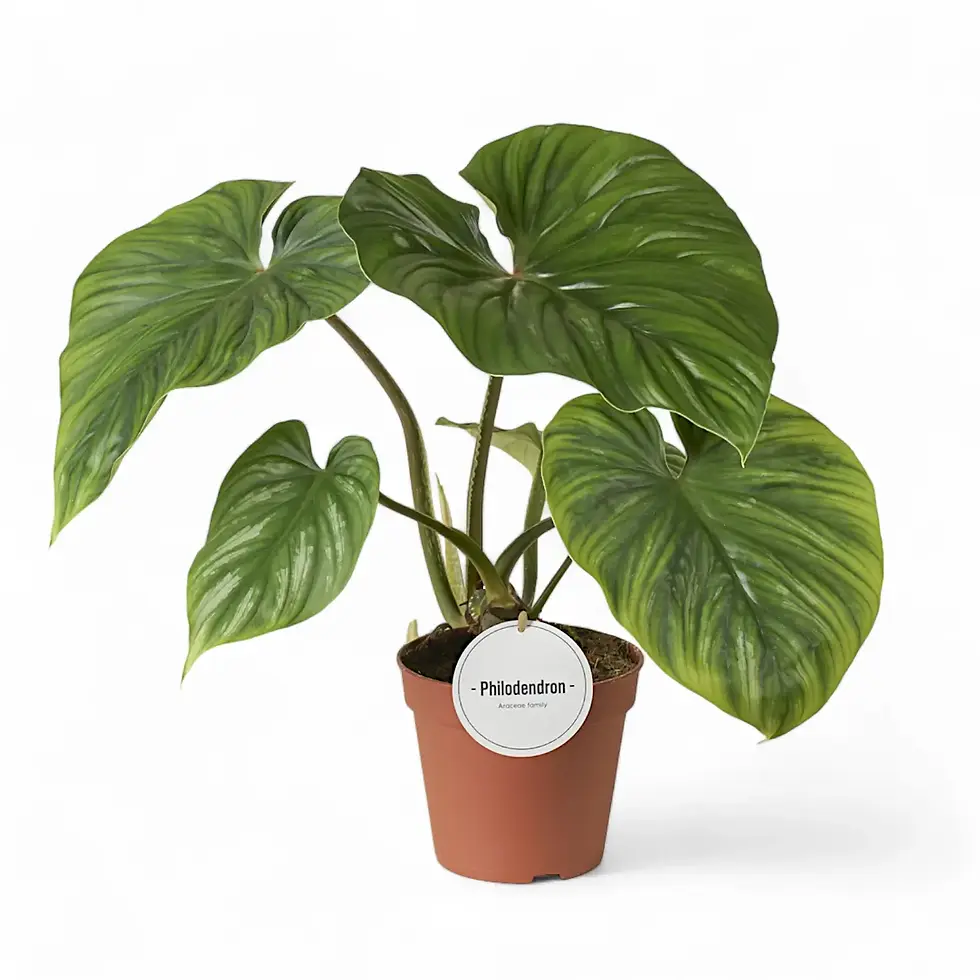Philodendron plowmanii – Sculptural Elegance from the Amazon Rainforest
Philodendron plowmanii is a rare, ground-crawling aroid native to the tropical rainforests of Ecuador and Peru. Its broad, quilted leaves and dramatic ruffled petioles make it a collector favorite for low, horizontal displays. With slow, stable growth and a strong architectural presence, this species adds grounded drama to curated indoor jungles.
Botanical Features of Philodendron plowmanii
- Leaf Texture: Deeply puckered, heart-shaped leaves with heavy venation; mature leaves can exceed 30 cm in width.
- Petioles: Ruffled, slightly reddish D-shaped petioles — a distinctive visual marker of the species.
- Growth Habit: Terrestrial creeper with a horizontal rhizome; ideal for wide pots and low containers.
- Leaf Variation: Natural color gradients and venation patterns shift with light and age — no two leaves are identical.
- Inflorescence: Mature specimens produce pale green to burgundy spathes with typical Philodendron spadix structure.
- Toxicity: Contains calcium oxalate crystals; toxic if ingested by pets or humans.
Native Habitat and Adaptation
Philodendron plowmanii grows in the shaded rainforest understories of Ecuador and Peru, typically at elevations of 300–1,200 m. It spreads horizontally along the forest floor, anchoring itself in loose, nutrient-rich soil and slowly advancing toward light gaps. High humidity, steady warmth, and diffused light are essential to its success both in nature and cultivation.
How to Care for Philodendron plowmanii Indoors
- Light: Bright, indirect light promotes strong texture and color. Avoid direct sun on tender young leaves.
- Watering: Water when the top 2–3 cm of soil are dry. Keep evenly moist, never soggy or bone dry.
- Humidity: Best leaf development occurs between 60–80 % humidity. Use grouped plants or a humidifier if needed.
- Temperature: Prefers 18–27 °C; avoid drafts and sudden temperature drops.
- Substrate: Use an airy aroid mix with perlite, orchid bark, coconut coir, and organic matter for nutrients.
- Fertilization: Monthly feed with balanced liquid fertilizer during growth. Avoid nitrogen-heavy formulas to prevent weak leaves.
- Repotting: Repot every 1–2 years into a wider container to accommodate rhizome spread.
Propagation and Special Notes
- Propagation: Divide rhizome sections with at least one leaf and root node. Root under high humidity in loose substrate.
- Support Needs: Does not climb — provide wide, shallow planters for stability and natural spread.
- Hydroponics: Can adapt to LECA or pon in semi-hydroponic systems if transitioned gradually.
Common Issues and Troubleshooting
- Yellowing Leaves: Usually from overwatering or compact soil. Adjust watering and improve aeration.
- Brown Tips: Caused by low humidity or underwatering — boost ambient moisture.
- Root Rot: Ensure free-draining substrate and avoid waterlogged conditions.
- Pests: Watch for spider mites, aphids, or mealybugs. Treat early with neem or insecticidal soap.
Botanical and Taxonomic Background
- Genus: "Philodendron" comes from Greek: "philo" (love) + "dendron" (tree), though this species grows terrestrially.
- Species Status: While Philodendron plowmanii is widely recognized among growers and collectors, it has not yet been formally described in peer-reviewed botanical literature.
- Name Origin: Named in honor of Timothy Charles Plowman (1944–1989), an American ethnobotanist noted for his research in the Amazon basin.
- Ecological Role: Helps stabilize rainforest soil and creates microhabitats in its native forest floor ecosystem.
Frequently Asked Questions – Philodendron plowmanii
- Does it need a moss pole?No. It is a non-climbing creeper — use a wide container instead.
- Can it tolerate low light?It survives in moderate light but thrives with bright, indirect exposure.
- How often should I water?Water when the top 2–3 cm of substrate is dry. Avoid extremes.
Order Philodendron plowmanii – Rare Texture, Natural Grounding
Bring a rainforest classic into your space with Philodendron plowmanii — a slow-growing, quilted foliage icon for horizontal planters and earthy design. Ideal for collectors looking beyond the usual climbers. Limited availability – order now to secure yours.
Philodendron plowmanii
Philodendron plowmanii comes in following sizes:
S – is approximately 20 cm tall and comes in a ⌀ 9 cm pot
M – is approximately 30 cm tall and comes in a ⌀ 12 cm pot
L – is approximately 50 cm tall and comes in a ⌀ 15 cm pot




















































